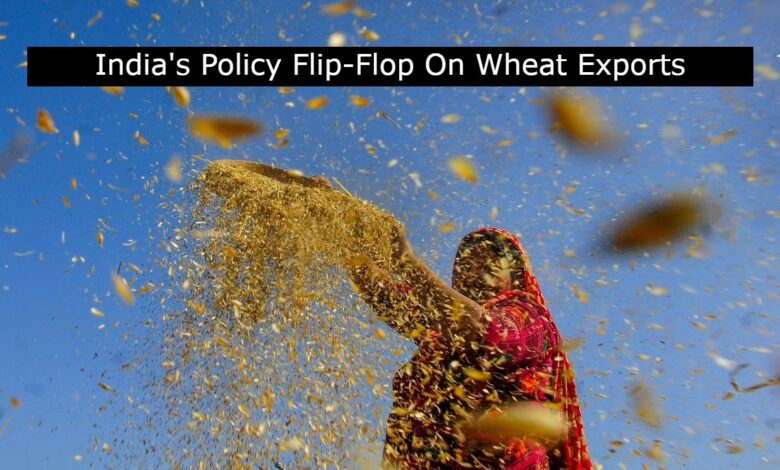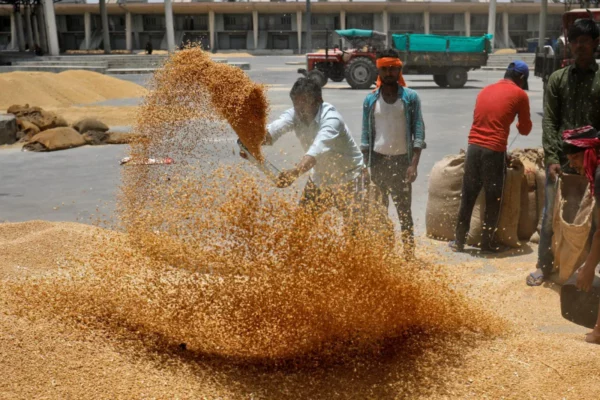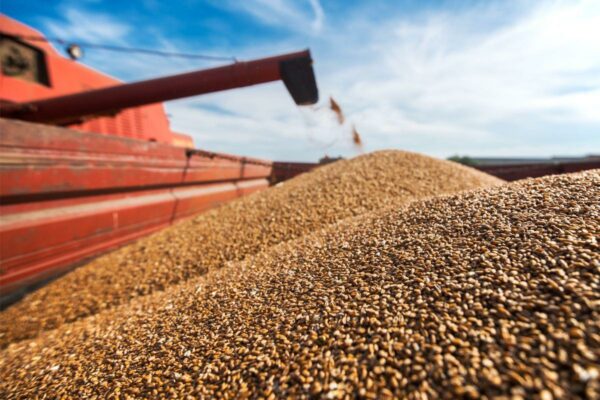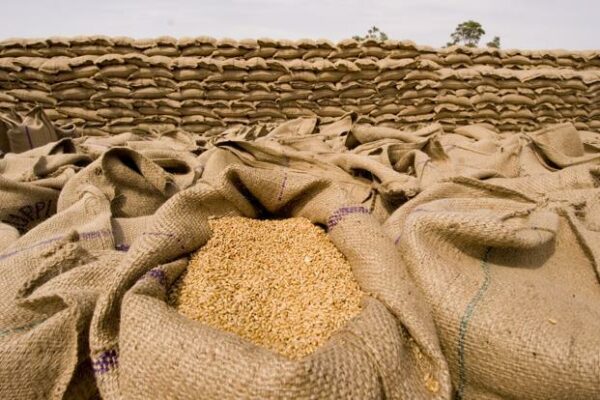India’s Policy Flip-Flop On Wheat Exports

India’s policy flip-flop on wheat exports
In the year ending in March 2022, India, the world’s second-largest producer of wheat, exported an unprecedented 8.2 million tonnes. In the current fiscal year, which ends in March 2023, the government claimed India might export anywhere between 10 and 15 million tonnes. Less than five million tonnes of export contracts have been signed thus far.
After previously claiming that its decision to prohibit wheat exports would assist solve a global supply shortage caused by the conflict in Ukraine, India has now justified the move.
The restriction was implemented by the Indian government two weeks ago due to worries that an early heat wave had damaged the nation’s harvests and raised local prices to record levels.
The current Russia-Ukraine war and the blazing warmth, which reduced production and caused domestic prices to reach record highs, are partially to blame for the country’s potential wheat scarcity. Since Russia invaded Ukraine at the beginning of this year, wheat prices have increased by more than 40% worldwide. A third of the world’s exports of wheat and barley were produced in Russia and Ukraine before the war.
Local wholesale prices decreased slightly but remained much higher than state support prices after the unexpected export ban that was imposed on a Friday evening, an alarming hint that the harvest is lower than anticipated.
To fill the market, the government should offer farmers a bonus. Later, the stocks can be utilized to control consumer pricing. In order to meet market pricing, farmers are given a bonus in addition to the government-mandated support prices.

The ban has also impacted more than just farmers. After paying a premium for wheat and shipping it to ports, small dealers that serve big exporters are facing enormous losses. Many exporters have cited the force majeure clause in order to refuse to unload trucks and fulfil contracts. Only export contracts supported by irrevocable bank letters of credit are now immune from the prohibition.
Inaccurate Crop Estimates:
Experts claimed that India’s policy reversals can be traced to inaccurate crop projections, which the country never acknowledged or resolved. For instance, the agriculture ministry anticipated the wheat crop to be a record 111 million tonnes in mid-February, but a heat wave ruined the harvest. But for domestic food management and export policy, the food and commerce ministries had to work with that inaccurate early estimate.
The food secretary predicted that the crop size will be lower, at 105 million tonnes, in early May. The agriculture ministry updated its projections on May 19 to 106.4 million tonnes.
Of course, the restriction was not the only measure India used to ensure its supply of wheat and control domestic pricing. Additionally, it lowered the amount of wheat that was allotted under the food assistance program and replaced a portion of it with surplus public rice reserves. The approximately 11 million tonnes of wheat that are saved in this way are expected to be utilized to lower market prices in the future or for exports between governments that are free from the embargo.
Siraj Chaudhry, chief executive of National Commodities Management Services Ltd, which offers services to store, transport, test, and exchange food and other commodities, cited a saying among commodity traders: “Buy the rumor, sell the fact.”
“The constant discussion of feeding the world heightened emotions. The export ban ended that bullishness, although prices did not drop significantly.
India, he continued, will continue to be vulnerable to a variety of concerns, including limited global supplies and rising energy and fertilizer prices that will drive up domestic food prices. As a result of better profitability and fewer policy concerns, he said, “and if cooking oil prices continue to remain steady, more Indian farmers may grow oilseeds during the winter crop season instead of wheat.”
India is not ‘a dinosaur’
According to UN Secretary-General Antonio Guterres, who spoke at the Global Food Security Call to Action ministerial meeting on May 18, the world’s hunger levels have reached a new high, with the number of people who are severely food insecure having doubled from 135 million before the pandemic to 276 million today. No export limits should exist, and surpluses must be distributed to those who are most in need, he argued.
It is simpler to say than to do. For instance, the prohibition on wheat exports by India is a result of a global wave of protectionism that was exacerbated by the conflict in Ukraine. One country that has restricted fertilizer exports is China, which has been importing food nonstop for more than a year.
To lower local prices, Indonesia prohibited palm oil exports in April; the ban was lifted on May 23. Argentina, the biggest supplier of soy oil and meal in the world, raised export duties in March due to drought and raging inflation.
Global trade will collapse if every nation starts enforcing export restrictions, but India may now take advantage of food diplomacy by keeping the door open for government-to-government exports.
Piyush Goyal, the minister of food and trade, said in an interview that the government was “responsive” to changing circumstances and wasn’t a “dinosaur” when it came to any issue, even though the goal of the wheat export ban was to ensure fair distribution of grains to countries in need rather than allowing speculators to manipulate the market.

“We want governments to communicate with us, and wherever we can help, we will do so.”
Additionally, the government declared that it will limit sugar exports to 10 million tons in an effort to maintain steady domestic prices. India is the second-largest exporter of sugar in the world, behind Brazil.
At a time when global resources are becoming more scarce and the United Nations has issued a warning about the possibility of a global food shortage in the near future, such restrictions are being perceived as a form of “food protectionism.”
However, the ban on wheat is what has sparked the most controversy and calls for its reversal.
The administration had stated that just two days prior to the ban that it would send delegations to nine nations to encourage the export of wheat.
The rapid reversal has been referred to as a “knee-jerk reaction” by several Indian agriculture specialists.
“This kind of flip-flop damages India’s reputation abroad. According to Harish Damodaran, the agriculture editor at the Indian Express newspaper, you proclaim a policy and then do the exact opposite. “While the reasons may be fair, I think they could have curtailed exports in a progressive fashion. Long-term, this will make it more difficult for the nation to develop markets for its agricultural products.
The sudden decision was made after the government’s procurement of less of the basic crop this year, which is typically purchased in large quantities for a big food security program that serves some 800 million people.
This was partly because crop yield was lower and partially because farmers sold more wheat to private traders this year, who bought it at higher prices as they anticipated brisk exports.
Farmers claim that the heat wave that hit early in March reduced their harvests by 15 to 20 percent, but estimates vary.
Farmers who expected to gain from increased worldwide prices this year have also been harmed by the restriction. For them, it was a double catastrophe. They were hurt because their harvests were hampered, and they are now unable to benefit from rising prices around the world.

Why did India decide to halt exports?
- The food security of India and other vulnerable nations is in jeopardy due to this year’s low wheat crop production.
- According to a notice published in the government gazette on Friday, May 13, 2022, India’s Directorate of Foreign Trade.
- This year’s intense temperature in India has caused the country’s wheat crop to produce less than expected.
- In part, the current war between Russia and Ukraine is to blame for the country’s potential wheat scarcity.
- India, the second-largest producer of wheat in the world, is attempting to control its domestic prices, which have reached a 12-year high.
- India’s wheat production did not significantly decline this year, but government authorities claim that uncontrolled exports caused an increase in local prices.
- Commerce Secretary BVR Subrahmanyam stated, “We don’t want wheat trade to happen in an unregulated manner or for there to be stockpiling.”
- The massive amount of wheat stored in India has been stressed by the 800 million individuals who received free food during the Covid-19 outbreak.
- According to India, wheat exports are still permitted in exchange for letters of credit that have already been given.
- India will grant exports upon request from nations looking to “meet their food security needs.”
How did the world react?
- After the Black Sea region’s exports fell sharply due to the conflict, importers throughout the world were counting on India for supply.
- The G7 industrialized nations’ agriculture ministers slammed India’s decision on Saturday right away.
- The issue would deteriorate if everyone began to apply export restrictions or close markets, according to the German agriculture minister.
- Given the existing limited supply, India’s prohibition may cause global prices to reach new highs, harming impoverished customers in Asia and Africa in particular.
- Due to Russia’s invasion of Ukraine, a traditional global breadbasket, shipments have been halted.
- Prior to the Russian invasion, Ukraine exported through its ports 4.5 million tonnes of agricultural products each month or 12% of the world’s wheat.
- According to German Minister Ozdemir, 20 million tonnes of wheat need to be quickly transported from Ukrainian silos.
- One of the main importers of wheat in the world, Egypt, declared on Sunday that the limitations do not apply to its government imports.
- It has agreed to purchase 500,000 tons of wheat from India, whose origin for imports was just approved.
After the wheat export ban, India has received requests from 5 countries:
Following India’s ban on wheat exports last month, at least five nations have requested the supply of the grain, including Bangladesh and Indonesia, one of the cereal’s major buyers worldwide, a government official said.
On May 13, India banned wheat exports in response to skyrocketing world prices, but it left open the possibility of G2G supply for neighbouring nations and those who would be at risk for food insecurity.

Okonjo Iweala Ngozi, the director-general of the World Trade Organization (WTO), stated on Sunday that nations should not underestimate the effects of export limits and that such actions may worsen the current global food crisis.
“You observed that precisely those activities did cause price hikes during the food crisis of 2008–2009. Our members are attempting to explain in the food security declaration how they would try to stop themselves from engaging in these kinds of actions, said Ngozi at a press conference in Geneva.
Since the prohibition, India has exported 1.8 million tonnes of wheat to a number of nations, according to the Food Secretary.
Farmers in India are feeding the globe. Egypt has accepted India as a wheat supplier. The Modi government comes in as the world seeks credible alternate sources of consistent food supply. Goyal declared in a tweet that “our farmers have assured that our granaries are full, and we are ready to feed the world.”
India’s wheat exports are primarily to neighbouring nations, with Bangladesh accounting for more than 54% of total volume and value in 2020-21. It has expanded into new wheat markets, including Yemen, Afghanistan, Qatar, and Indonesia.
The top 10 countries importing Indian wheat in 2020–21 were Bangladesh, Nepal, the United Arab Emirates, Sri Lanka, Yemen, Afghanistan, Qatar, Indonesia, Oman, and Malaysia.
India accounts for less than 1% of global wheat exports. Its proportion, however, has climbed from 0.14 percent in 2016 to 0.54 percent in 2020. India is the world’s second-largest wheat producer, accounting for around 14.14 percent of total global production in 2020.
India produces approximately 107.59 million tonnes of wheat per year, with the majority of it consumed domestically.
Gujarat, Uttar Pradesh, Haryana, Rajasthan, Madhya Pradesh, Bihar, and Punjab are the biggest producers of wheat in India.
Between 1 April and 14 June, India exported 2.97 million tonnes (mt) of wheat and around 259,000 tonnes of atta. Wheat prices fell somewhat in the wholesale food inflation index, while overall food inflation climbed. Wholesale food inflation increased by two percentage points to 10.89 percent in May, after falling by two percentage points in April compared to March.
India has sent 1.8 million tonnes of wheat to at least a dozen countries, including Bangladesh and Afghanistan, since the country stopped exporting wheat on May 13, according to Food Secretary Sudhanshu Pandey.
According to him, around 33,000 tonnes of wheat have already been delivered to Afghanistan as humanitarian assistance, against a commitment of 50,000 tonnes.
Pandey remarked on June 24 at a ministerial summit on ‘uniting for global food security in Berlin, Germany, that India has always taken the needs of the globe into account, even while meeting the onerous responsibility of feeding its 1.38 billion-person population.
According to the secretary, the Indian government has decided to restrict wheat exports in order to ensure both local availability and availability to vulnerable regions whose supply cannot be controlled by market forces.
According to him, 1.8 million tonnes of wheat were exported from the start of the regulation through June 22 of this fiscal year, which is nearly four times more than the previous year. These nations included Afghanistan, Bangladesh, Bhutan, Israel, Indonesia, Malaysia, Nepal, Oman, the Philippines, Qatar, South Korea, Sri Lanka, Sudan, Switzerland, Thailand, the United Arab Emirates, Vietnam, and Yemen.
The government stopped wheat exports with immediate effect on May 13. It shifted the export of all wheat types, including high-protein durum, from “free” to “prohibited.”
The approach was made to keep growing wheat prices in the domestic market under control.
India shipped a record 7 million tonnes of wheat during the fiscal year 2021-22, he claimed, when the country generally exports approximately 2 million tonnes, accounting for about 1% of global wheat trade.

Pandey stated that India is acutely aware of its responsibility to the most vulnerable people around the world and that the government continued to give humanitarian help, both through the supply of vaccines and food consignments, during and after the pandemic.
For example, the government has sent many shipments of humanitarian relief to the people of Afghanistan, including 33,000 tonnes of wheat out of a total pledge of 50,000 tonnes made by Prime Minister Narendra Modi, and continues to do so in the aftermath of the recent earthquake, he said.
During the epidemic, India sent wheat, rice, pulses, and lentils to various nations throughout the world, including Afghanistan, Comoros, Djibouti, Eritrea, Lebanon, Madagascar, Malawi, Maldives, Myanmar, Sierra Leone, Sudan, South Sudan, Syria, Zambia, Zimbabwe, and others, he said.
During the COVID pandemic, India launched the world’s largest food assistance program, covering approximately 810 million people.
“We are still giving these starving people food assistance more than two years later, despite the fact that their population is almost similar to that of Europe and the United States combined.”
He said that to ensure effective targeting, “the entire system was run on a massive technology platform that was biometrically validated.”
The UN Secretary General’s efforts to increase global food security have been acknowledged by India, according to the UN Secretary General’s office, and the country has welcomed the Global Crisis Response Group Task Team’s recommendation to immediately waive food export restrictions on purchases made by the World Food Program for humanitarian aid.
We have highlighted the necessity to grant these exemptions to other member countries and major participants who are supporting this global humanitarian operation, he continued.
Pandey went on to say that the COVID-19 epidemic has had a significant impact on global food security, which has been compounded by recent geopolitical upheavals and the influence of climate change. He also stated that the world is currently facing rising food, fertilizer, and fuel prices. The Global South, developing and least developed countries, and the world’s most vulnerable have been disproportionately affected.
Edited by Prakriti Arora




